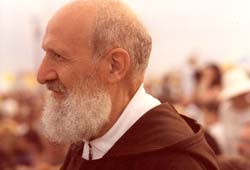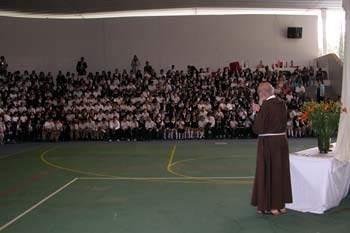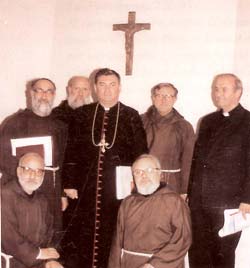 Was born on 15 February 1935. He studied at the University of Perugia; after visiting Assisi he examined his whole life in the light of the Gospel. He abandons his university studies and – after receiving the approval of Padre Pio from Pietrelcina, his spiritual Father – he entered the novitiate of the Capuchin Friars in Abruzzo on 8 December 1955. He became a priest on 25 March 1962. In 1970 he graduated in Letters and Philosophy with highest honours at the “La Sapienza” University of Rome. Was born on 15 February 1935. He studied at the University of Perugia; after visiting Assisi he examined his whole life in the light of the Gospel. He abandons his university studies and – after receiving the approval of Padre Pio from Pietrelcina, his spiritual Father – he entered the novitiate of the Capuchin Friars in Abruzzo on 8 December 1955. He became a priest on 25 March 1962. In 1970 he graduated in Letters and Philosophy with highest honours at the “La Sapienza” University of Rome.
The basis of his work is prayer and he conveys this spirit to those around him. Some tenets of his spiritual direction are: Consecration to God the Father with Mary, through Mary and in Mary; daily Communion and recitation of the entire Rosary; Confession every eight or at most 10 days. The fruits of this linear work of apostolate are Christian families and vocations which have developed within the Armata Bianca and which have then been fulfilled in the Order of the Capuchins, of the Trinitarians, of the diocesan clergy and in cloistered life (Carmelite Order, Adoring Handmaids), in Italy and in Eastern Europe.
His view of Franciscan life – contemplative and missionary – is laid out in a short publication “Francis, yesterday, today and tomorrow”.
Since 1973 – with the blessing and consent of his Superiors – Father Andrea has engaged in various forms of apostolate, including the Armata Bianca and Children’s Nests of Prayer.
 The Armata Bianca The Armata Bianca
“Children will save the world!”, P. Pio from Pietrelcina repeated many times, in urging the gathering of children into “Nests of Prayer” (this is the name he gave them) for the recitation of the rosary and for Eucharistic adoration. The only person who accepted this invitation was the Servant of God Father Pio Delle Piane, of the Order of Minims, who was very united in spirit to the stigmatized priest of the Gargano.
In 1972, in obedience to Fr. Pio Delle Piane – his new spiritual father after the death of Padre Pio from Pietrelcina – Fr. Andrea D’Ascanio began his work with children which will become the heart of his apostolate.
This apostolate essentially consists in inviting children to offer themselves to their Heavenly Father – in Mary, with Mary and through Mary – for the salvation of the world; in gathering them into “Nests of Prayer” for the recitation of the rosary and for Eucharistic Adoration; in preparing them for First Communion “at the first use of reason” according to the instructions given by Saint Pius X and also reproposed by the New Code of Canon Law.
The Movement is called Armata Bianca because P. Pio from Pietrelcina called the rosary his “weapon” (arma), thus “Armata”; “Bianca” (white) in reference to the innocence of children and to their prayer for peace.
In 1989 Pope John Paul II granted a special audience to 10,000 children from the Armata Bianca: this was the first time in history that such a large audience was given to children alone.
From 1989 to 2000 Fr. Andrea edited two quarterly publications, one for children (The Nests of Prayer of the Armata Bianca, with the printing of 20,000 copies) and another to spread the knowledge of God the Father and the Love for Him (“God is Father”, with 16,000 copies).
In 1990 the Armata Bianca began its work in Africa, Eastern Europe, Latin America, the United States, Canada and many other countries where it has encountered over two million children who have each received a rosary and a leaflet explaining how to pray the Rosary.
 Peregrinatio Mariae in Eastern Europe Peregrinatio Mariae in Eastern Europe
The spirituality of the Armata Bianca is based on Fatima, whose message especially concerns Russia: “If my requests are heeded, Russia will be converted and there will be peace; if not, she will spread her errors throughout the world, causing wars and persecutions against the Church. The good will be martyred, the Holy Father will have much to suffer and various nations will be annihilated. In the end my Immaculate Heart will triumph. The Holy Father will consecrate Russia to me, and she will be converted, and a period of peace will be granted to the world”.
It is obvious that the Armata Bianca has always given special attention to this land which Mary has placed at the centre of Her great manifestation. In 1989 the borders of Eastern European countries began to open and Fr. Andrea D’Ascanio, with the Armata Bianca, organized the Peregrinatio Mariae with the Virgin of Fatima in Bulgaria, Romania, Ukraine, Belarus and Russia, and visited these countries again over the years.
In agreement with the Bishops of the various dioceses – and with their respective Nuncios when these are appointed – from 1990 to 1996 he approached thousands of worshippers in numerous parishes of these nations, and has distributed hundreds of thousands of Rosaries and printed leaflets in various languages in order to teach people how to pray it; 200,000 icons of the Hearts of Jesus and Mary; statues of the Virgin of Fatima, so that the Peregrinatio could then continue in the various families; tens of thousands of Bibles, Gospels and Catechisms.
The spiritual fruits of these Peregrinatios are remarkable. We will list a few of them:
 a. The Implantatio Ordinis of the Capuchins in Romania a. The Implantatio Ordinis of the Capuchins in Romania
During the peregrinatio in Romania, at the beginning of the 1990’s, Father Andrea D’Ascanio noticed that the wealth of priestly vocations that was flourishing there wasn’t supported by appropriate structures to receive them. The Bishops of Bucharest and Iasi asked him to try to make the Capuchins – who had never been present in Romania – send some of their Friars there. In fact, Blessed Jeremy of Valacchia – the only Romanian saint in the Catholic Church – went from Romania to Italy to enter the Capuchin Order of Naples.
Therefore in agreement with the Father General of the Capuchin Fathers, Fr. Flavio Carraro (subsequently the Bishop of Verona) and with the Definitor General for the East Fr. Pacifico Dydycz (now Bishop of Drohiczyn, in Poland), Fr. Andrea D’Ascanio strived in this direction and after much insistence managed to convince the Provincial of Naples to send two religious to this land. He accompanied them together with the Provincial Father in order to introduce them to the Bishop of Iasi; then he lead them to Onesti where the Sanctuary in honour of Blessed Jeremy was being built and helped them to find the premises on which to set up the first seminary.
At present there are 150 seminarians in Romania and – in Naples – 15 novices, 15 probands and 10 Philosophy students. The Superiors of the Order have given an official acknowledgement to this collaboration with the Armata Bianca in the Analecta Ordinis:
“Act of gratitude. At this time we must remember the great importance of the Armata Bianca directed by our brother Fr. Andrea D’Ascanio, under the protection of Our Lady of Fatima. And then, our brother Fr. Mario Querini of the Province of Rome has been in Romania since 2 July, and works in Onesti, at the invitation of the pastor Msgr. Edoardo Sechel, in the Diocese of Iasi” (Analecta Oridnis Fratrum Minorum Capuccinorum – Ian-Maii 1992).
b. The Ecumenical House in Romania
Also in Onesti, in 1991 during the second Peregrinatio, Fr. Andrea D’Ascanio received as a gift from an elderly lady – a Franciscan tertiary who, for the first time after 50 years, has seen a Franciscan religious in her country – a piece of land and a villa whose construction has already begun, to be used for a religious cause.
At the request of Fr. Flavio Carraro, the Minister General, Fr. Andrea D’Ascanio managed to convince Fr. Mario Quirini, of the Roman Capuchin Province, to come to Romania and to work for ecumenism.
The Ecumenical House, which was inaugurated in 1995, arose on the donated land. It has a big chapel, a meeting room, 20 rooms and other premises, in which Orthodox and Catholic priests meet in a climate of true brotherhood: it is the most remarkable achievement in all of Eastern Europe in terms of ecumenism.
c. The sending of missionaries to the East
With the peregrinatio Mariae Fr. Andrea D’Ascanio had the opportunity to have a first-hand knowledge of the great needs of Catholic priests and nuns of the Churches of Eastern Europe, and he strove to allow other religious to go there as missionaries. The Bishop of Russe in Bulgaria asked him to get in contact with the sisters of Mother Teresa of Calcutta: four of them went to that nation. The Minim Sisters of Our Lady of Suffrage went to Romania on numerous occasions and then settled there permanently. A few Lay Salesian Coadjutors made arrangements to open workshops in the Ukraine.
d. Religious material for the new churches
Father Andrea D’Ascanio, both in order to provide for the real necessities of many churches in the East and in order not to allow the sacred material which the new liturgy has made superfluous to fall into desecrating hands, asked parishes and convents for holy ornaments. Many shipments were made to a centre in Trieste which then sent these ornaments to the Eastern countries and to former Yugoslavia, where they had been buried under the rubble of more than 700 churches.
e. Radio East Maria
Considering the great difficulty in communication and the vast areas which the few priests had to serve, Fr. Andrea D’Ascanio had the insight, which then turned out to be vital for the evangelization of Eastern Europe, to provide the parishes with private radio transmitters. With great risk and a little at a time, the Armata Bianca managed to secretly bring seven transmitters beyond the curtain with the relative equipment for broadcasting in Moscow (Russia), Kiev, Harrachov, Berdichev, Vinnitsa (Ukraine), Drohiczyn (Poland) at the Belarus border. In Moscow it was handed over to Msgr. Bernardo Antonini who received from the Government a frequency channel for all of Russia and Radio Moscow Maria, from the Italian Radio Maria, was set up on it.
f. Filmed interviews of the martyrs of Communism
Since he had the opportunity to meet many elderly priests and lay people who had terrible experiences in prisons, concentration camps and hard labour in Siberia, Fr. Andrea D’Ascanio began to gather filmed interviews of the few elderly people who survived, before death would swallow up these marvellous witnesses of faith who are the new Acta Martirum of the Church. These interviews were then published in various videocassettes.
 The battle against abortion: the burial of unborn children The battle against abortion: the burial of unborn children
Since he works with children, Father Andrea D’Ascanio takes care of the smallest among children: babies killed by abortion. In order to stop the spreading of this “abominable crime”, and heeding Pope John Paul II’s heartbroken cry: “Stop this slaughter!” he established the Armata Bianca’s Pro-Life Movement in Aquila which is engaged in fighting against abortion by fighting for the opportunity to bury the corpses of babies killed in hospitals.
Fr. Andrea maintains that abortion is above all the result of ignorance and cultural superficiality and he is therefore trying to develop a basic principle in order to convince men that abortion is true murder: in cemeteries only corpses, that is the bodies of dead people, are buried; if we could bury the remains of children killed by abortion, everyone would obviously realize the elementary concept of burial = corpse = murder.
In 1986 Fr. Andrea D’Ascanio organized the Week for Life in the diocese of Aquila and, during the final speech of the conference he declared that the Armata Bianca would fight in order to obtain the corpses of babies killed in hospitals in order to give them a dignified burial.
Together with Prof. Giovanni Antonucci (who is now a priest) and other members of the Movement, he developed a thorough study on the obituary legislation which is in force in Italy, and was thus able to obtain – in perfect legality and for the first time in the world – the “abortive remnants”, that is the little bodies of the babies killed at the hospital of Aquila and to arrange for their burial in the town cemetery.
After performing burials for two years – a deed which was completely endorsed by the Archbishop Msgr. Mario Peressin – we were able to obtain permission to place a statue dedicated to Mary Mother of the Unborn on the spot where the babies were buried. The monument was unveiled on 28 December 1991 and was highlighted in newspapers and on television.
This deed brought about a great defamatory campaign on the media all over the world, and it has never ceased. Pro-abortionists have since then sought every opportunity to attack Father Andrea and the Armata Bianca. However, in spite of this, neither has the Armata Bianca stopped its work, and following the necessary procedure, always in the name of the Armata Bianca’s Pro-Life Movement in Aquila, it obtained the burial in many other cities in Italy and abroad.
In several other cemeteries, there is a copy of the statue of Mary Mother of the Unborn which is found in Aquila.
Encouraged by this example, Card. O’Connor of New York gave orders that in all the cemeteries of his archdiocese a monument which commemorated Unborn Babies was to be placed. In Guayaquil and in Quito (Ecuador) a copy of the statue of Mary Mother of the Unborn was placed in the main town cemetery, in a beautiful background, and around it babies killed by abortion are still buried. A copy of this statue was placed for the public’s attention in Torun, in Poland, in the area opposite the headquarters of the Polish Radio Maria and in many other cemeteries around the world.
The Armata Bianca is carrying out this project in many places, amid incredible conflict. This annoys well-identified political and ideological groups very much. We believe that at the basis of the whole denigrating campaign against the Armata Bianca and its Founder Fr. Andrea D’Ascanio there is above all this effective and constant effort against abortion.
 The Love and knowledge of God the Father The Love and knowledge of God the Father
God the Father is the great stranger, even though the whole Liturgy makes reference to Him. In reality, almost everyone considers Him only in the light of a fearful judge, nullifying the words of infinite tenderness which Jesus gave us regarding “his Father and our Father”.
In order to help men know and thus love their Heavenly Father, Fr. Andrea D’Ascanio is spreading the Father’s Message – which was acknowledged as valid by the Church after a long and thorough examination which lasted 10 years – which is working innumerable conversions, many of which have written testimony. This Message is now translated in 24 languages and published in hundreds of thousands of copies.
For more than thirty years, in many cities of the world, Father Andrea has been organizing a nightly vigil of adoration, before the Eucharistic Jesus, from the 6th to the 7th of each month, in honour of God the Father, which lasts the entire night. The intent of the vigil is to ask the Father to establish his reign of Love on earth as soon as possible.
In addition, Fr. Andrea D’Ascanio has organized conventions, retreats, spiritual exercises and meetings, in Italy and throughout the world, on the Person of God the Father who “isn’t known, honoured and loved by his children, by all mankind”. For this reason he directs the consecration of children toward the Father, teaching them to call Him “Daddy”.
His is convinced that a true and solid ecumenism can be accomplished only in the Father; only in Him will we be able to reach true UNITY.
|

 Was born on 15 February 1935. He studied at the University of Perugia; after visiting Assisi he examined his whole life in the light of the Gospel. He abandons his university studies and – after receiving the approval of Padre Pio from Pietrelcina, his spiritual Father – he entered the novitiate of the Capuchin Friars in Abruzzo on 8 December 1955. He became a priest on 25 March 1962. In 1970 he graduated in Letters and Philosophy with highest honours at the “La Sapienza” University of Rome.
Was born on 15 February 1935. He studied at the University of Perugia; after visiting Assisi he examined his whole life in the light of the Gospel. He abandons his university studies and – after receiving the approval of Padre Pio from Pietrelcina, his spiritual Father – he entered the novitiate of the Capuchin Friars in Abruzzo on 8 December 1955. He became a priest on 25 March 1962. In 1970 he graduated in Letters and Philosophy with highest honours at the “La Sapienza” University of Rome. The Armata Bianca
The Armata Bianca  Peregrinatio Mariae in Eastern Europe
Peregrinatio Mariae in Eastern Europe a. The Implantatio Ordinis of the Capuchins in Romania
a. The Implantatio Ordinis of the Capuchins in Romania The battle against abortion: the burial of unborn children
The battle against abortion: the burial of unborn children The Love and knowledge of God the Father
The Love and knowledge of God the Father